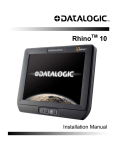Download iogear GUWAVKIT4
Transcript
User Manual Wireless 1080p Computer to HD Display Kit GUWAVKIT4 PART NO. M1227-a www.iogear.com Table of Contents Introduction 4 Package Contents 4 Requirements 4 Specifications 5 Overview 6 Prepare to Software Installation - Windows 6 Software Installation - Windows 7 Hardware Installation 10 Using the IOGEAR Wireless Software - Windows 12 Troubleshooting and Support 21 Federal Communications Commission (FCC) Statement 26 Limited Warranty 27 Contact 27 3 Introduction The GUWAVKIT4 Wireless 1080p Computer to HD Display Kit allows users to watch and share any notebook or PC content (such as pictures, movies and presentations) and any Internet content on their HDTV, projector, or monitor without cable limitations and in up to stunning 1080p HD. The GUWAVKIT4 transmitter connects to a USB 2.0 port available in the notebook PC and the Receiver Base connects to either an HD port available in flat screen TV or a VGA connection in monitors & projectors. Stereo audio is supported via the HD port (along with the video) or via a separate 3.5mm audio jack. The GUWAVKIT4 provides full room coverage, is easy to set up and use, and is an ideal solution for both home and office use. It delivers the best combination of performance and cost in a variety of living room, conference room and classroom environments. Package Contents 1 x Wireless A / V Receiver 1 x Wireless USB Transmitter 1 x Power Adapter 1 x User Manual 1 x Warranty/Registration Card 1 x Installation CD for PC Requirements PC: • Intel 2.2GHz processor (2.4GHz Recommended) with 2GB (3GB Recommended) of system memory (RAM) • Windows® XP (32-bit) SP3, Windows Vista® SP2, Windows® 7, Windows® 8 • Graphics Chipsets Supported: Intel, AMD, and nVIDIA • An available USB 2.0 Port TV: • HDTV or Projector with HD, VGA (RGB / D-sub 15-pin / PC), or DVI port (DVI adapter not included) • TV or audio system with HD or 3.5mm audio jack 4 Specifications Base Receiver • Video Out: HD Connector, VGA Connector • Audio Output: 3.5mm Stereo Jack • USB 2.0 port to support keyboard and external hard drives. • Streaming video up to 1080p resolution • Supports both Mirror Mode and Extended Mode (TV/monitor as a second screen) • 48 kHz, 16-bit Stereo via audio jack or HD connector • Whip Antenna • 5VDC Power Adapter • LED power and Tri-color signal strength indicators PC Adapter • USB Type-A male • Internal transmission antenna Standards • Wireless USB 1.0, UWB certified • Certified WiMedia PHY and MAC General • Same room, line of site range, up to 30ft • 128-bit AES security • Software drivers: Windows® XP (32-bit) SP3, Windows Vista® SP2, Windows® 7, Windows® 8 • Input voltage: 100-240V, 50/60Hz • Operating temperature range: 0-40 C 5 Overview 1 2 Receiver Base Front View 1.Power / Signal Indicator Light 2.Wireless Connection LED Light 1 2 3 4 5 Receiver Base Back View 1.DC Power Input 2.HD Port 3.D-Sub 15Pin (VGA) 4.3.5mm Audio Out 5.USB 2.0 Port 6.Antenna 6 1 PC Adapter 1.USB 2.0 Prepare to Software Installation - Windows If your PC contains a previous IOGEAR Wireless Software or other Wireless USB driver installation, please perform a proper uninstall procedure using the Windows Control Panel. Prior to Software Installation: 1. It is important to make sure there is no prior installation of Wireless USB or Display Link software from IOGEAR or other com¬panies. IF YOU HAVE THIS SOFTWARE IN YOUR SYSTEM, THIS WILL CAUSE THE IOGEAR WIRELESS SOFTWARE NOT TO WORK PROPERLY. 2. Go to Control Panel>Programs and Features and look through your programs to ensure you do not see any UWB wireless programs. 3. If you see any UWB wireless programs listed under program name, uninstall it by highlighting and clicking on the Uninstall tab. 4. The installation software requires .NET Framework version 2.0 (or later) to be installed on the computer. In case it is not installed it may be downloaded from the following location: http://www.microsoft.com/downloads/details.aspx?FamilyID=0856EACB-4362-4B0D8EDD-AAB15C5E04F5&displaylang=en 5. Anti Virus software set to very high security may prevent the installer from running. It is recommended to temporarily disable the Anti viruses SW during the installation. 6 Software Installation - Windows 1. The installation checks the PC capabilities and compares them to the minimum system requirements of the system. For Vista/Win7 it is recommended to run WEI (Windows experience index) calculation prior to installation. 2. Ensure that the PC Adapter is unplugged from the PC. Software Installation 1. Insert the installation CD in the PC CD-ROM drive 2. The installation CD License Agreement menu is displayed below. 3. Check the “I agree to the license terms and conditions” box and click on “Install”. 4. The software will automatically create a folder and load the software content into the C: drive in the Program Files folder. 5. The software will automatically create a folder and load the software content into the C: drive in the Program Files folder. 7 6. During software installation, the Operation Progress screen will appear. 7. Once Setup is completed, the Operations Successful screen will appear. Click on “Restart” to restart your computer. Uninstalling the Software (2) Methods: Method 1 1. In the event you need to uninstall the software, insert the CD. Once the Modify Setup screen appears, click on “Uninstall”. Note: The Modify Setup screen will only appear if the IOGEAR wireless software is already installed on your PC. 2. An Operation Progress screen will appear during the Uninstall process. 3. Once the Uninstall process is completed, an “Operation Successful” screen will appear. Click on “Restart” to restart your PC and complete the Uninstall process. 8 Method 2 1. Click on Windows Start button on your desktop and select Control Panel>Program and Features. Uninstall the following program: GUWAVKIT4 Repairing the Software: 1. In the event you need to repair the software, insert the CD. Once the Modify Setup screen appears, click on and click on “Repair”. Note: The Modify Setup screen will only appear if the IOGEAR wireless software is already installed on your PC. 2. An Operation Progress screen will appear during the Repair process. 3. Once the Repair process is completed, an “Operation Completed” screen will appear. Click on “Restart” to restart your PC and complete the Repair process. 9 Hardware Installation 1. Connect the Wireless USB PC Adapter 1.Connect the Wireless USB PC Adapter to a high speed PC USB port. 2.The system will automatically detect and install the drivers. 2. Connect the Power Adapter 1.Plug the AC Adapter cord into the DC-IN on the back of the Receiver Base. 2.Connect the AC adapter a live electrical outlet. The power light on the front panel glows red when the Receiver Base is powered on. 3. Connecting a TV, Monitor or Projector 1.You can connect a digital (HD) or analog (VGA) monitor to the Receiver Base. Note: Only one monitor can be connected to the HD Adapter at a time. 2.Connect an HD or VGA Cable to the HD or VGA port on the Receiver Base 3.Connect the other end of the cable to the TV, Projector or external monitor. Option 1 - HD Option 2 - VGA 10 4. Connecting Audio Devices 1.The Wireless USB Device Adapter provides one 3.5mm port, as shown in the illustration above. Note: HD and 3.5mm options may be operated simultaneously 5. Set-Up Complete 1.The default configuration for the external monitor connected to the Receiver Base is in the Extend mode (an extension of the image on the computer to a second screen). 2.When the PC’s image is displayed on the display/monitor, the Wireless Connection LED Light bar on the front panel will glow blue. The Power/Signal light will either glow green (good signal), orange (fair signal) or red (weak signal) depending how far away the PC/PC Adapter is from the Receiver Base. For best video image results, please position the PC/ PC Adapter close enough to the Receiver Base so that the Power/Signal Indicator Light shows green. 6. Connecting USB Devices* (Optional) 1.The Receiver Base provides one USB 2.0 port 2.Connection can be made to an External HDD’s, IOGEAR wireless keyboard etc. *Webcam’s are not supported. Notes: IOGEAR Wireless AV Multimedia Keyboards with trackball make a perfect companion: GKM561R, GKM681R, GKM581R and GKM571R 11 Using the IOGEAR Wireless Software - Windows This section provides information on using the following software to manage the IOGEAR Wireless Software to adjust settings to suit your needs: 1. UWB Connection Manager 2. Adjusting Video Settings 3. Adjusting Audio Settings You can also refer to this section to learn how to uninstall the software. 1. Introducing the UWB Connection Manager Software The UWB Connection Manager is the driver software for your GUWAVKIT4. This driver is automatically installed when you run the IOGEAR Wireless Software Installation CD. The GUWAVKIT4’s USB Wireless PC Adapter contains a radio transmitter that enables your computer to communicate wirelessly with the Receiver Base. This radio is known as the host radio. The UWB Connection Manager driver software enables you to manage the host radio and perform tasks such as the following: • Connect/Disconnect the GUWAVKIT4 from your computer • Change/Select the channel used for radio communication • Disable/Enable radio communications • Disable/Enable pop-up messages A: Accessing the UWB Connection Manger B: Accessing the UWB Connection Manger - To start the UWB Connection Manager: Double-click the UWB Connection Manager icon in the System tray/Notification Area of your Windows® desktop. Note : The UWB Connection Manager icon appears as Green in your System tray/Notifica¬tion Area only when the USB Wireless PC adaptor is connected to your computer. You may need to click the Show Hidden Icons button to display hidden icons. If the icon is not displayed in the System Tray Notification Area, you can access the UWB Connection Manager by double clicking the UWB Connection Manager icon on your Windows® desktop. 12 C: The UWB Connection Manager display window will show the GUWAVKIT4(s) on the Devices tab as Not Connected. Simply click on the Connect tab to establish a connection. It will take approximately 15 seconds for the Drivers to load upon first connection. When the wireless connection has been made, a yellow star will automatically appear next to the GUWAVKIT4 Icon, making it the default device for future connections. If the external monitor connected to the Receiver Base shows only the wallpaper background of my Windows® desktop, please refer to Page.15 to set the display mode to Mirror Mode. D: Disconnecting the GUWAVKIT4 from your computer - On the Devices tab of the UWB Connection Manager, right click on the connected GUWAVKIT4 and unselect “Set as Default”. Once the device is no longer the default device, you can then either, a) double click on the device, or, b) right-click and select “Disconnect”. The device will now move back to the “Not Connected” status. F: Renaming the GUWAVKIT4 - You can change the name of the each GUWAVKIT4 listed on the Devices tab of the UWB Connection Manager. This is especially useful if you have multiple GUWAVKIT4s to differentiate. To rename a GUWAVKIT4, right-click on the default name, select Rename from the shortcut menu, and then enter a custom name. tab of the Wireless USB Manager. This is especially useful if you have multiple IOGEARGUWAVKIT4s, to differentiate between them. To rename an IOGEAR-GUWAVKIT4, right-click on the default name, select Rename from the shortcut menu, and then enter a custom name. 13 G: Radio Communications Change/Select the channel used for radio communication The Communications tab of the UWB Connection Manager enables you to view and change radio settings. The default channel setting is Automatic, which enables the host radio to automatically locate an available channel for communications. Note: It is recommended to leave this setting on Automatic. If you manually select a channel that is being used by another GUWAVKIT4 in the vicinity, the channel bandwidth will be shared by both devices. To maximize performance, there are eight channels to choose from and a separate channel should be used for each GUWAVKIT4. H: Disable/Enable Radio Communications - To temporarily disable the host radio, do the following: Under the Communications tab, click the Off button in the Communication Status. The radio is now in Airplane Mode and the UWB Connection Manager Icon in the System Tray will now turn Orange: 14 2. Adjusting video settings A. Selecting Extended mode or Mirror mode You can choose to set the USB to VGA Adapter’s video output signal to Extend mode or Mirror mode. The default setting is Extend mode. Extend mode extends your desktop space across multiple monitors, so that you can display different information on each monitor connected to your computer. This provides a number of advantages to increase productivity, including the ability to: • View large spreadsheets across two screens • Multitask more effectively without overlapping windows • Compare two documents simultaneously across two screens • View videos/TV on one screen and reviews on the other Mirror mode duplicates the image on your computer screen on the external monitor(s) connected to USB to VGA Adapter. This mode is useful if, for example, you want to view information on a larger, external desktop monitor instead of a smaller, built-in computer screen. In Mirror mode, the Adapter automatically adjusts the external monitor’s resolution, color quality, and refresh rate settings to provide the best overall image quality based on your computer’s settings. 15 B. Configuring the Display 1.Setting options for the display The following are the suggested work configurations when connecting a display screen to the Base Adapter: • Mirror Mode • Extend Mode • Laptop with Lid Closed • External Display Only 2.Configuring the Display in Windows XP/Vista 1) Using Viewspan icon in System tray/Notification Area Advanced Settings Configuring the Display via Windows Display Properies in Windows XP/Vista Extend to Specify the extension direction if you are using multiple monitors and Extended mode. This setting should match the physical orientation of the connected monitors relative to each other. For example, if the external monitor is physically positioned to the right of your computer’s display, select “Extend to Right”. Set as Entended Extend your desktop space across multiple monitors, so that you can display different information on each monitor connected to your computer. Set as Mirror Duplicate the image showing on your computer’s screen on the external monitor Set Display Off Turn off the external display. 16 2) Using Windows Display Preperties on Windows XP/Vista Setting the Display to Extend or Mirror Mode • Mirror Mode : uncheck the option “Extend my Windows desktop on to this monitor” • Extend Mode : check the option “Extend my Windows desktop on to this monitor” Adjusting Screen Resolution Use the Resolution slider to adjust the desired resolution of the display Adjusting Color Level (Color quality) Use the Colors drop-down box to select a color complexity level) Setting the Primary Display Select the screen that is connected to the Base Adapter- for example 2.Default Monitor as shown in the screen above Check the option Extend my Windows desktop onto this monitor (in Windows Vista – Extend the desktop onto this monitor”) Check the options Use this device as the primary monitor (in Windows Vista-This is my main monitor) Click OK to save the new settings. 3.Configuring the Display in Windows 7 1) In windows 7, there is a built in support for external monitor. To use it press the windows key together with the P key( + P), and then the following menu will apper: 1) For Mirror mode: choose Duplicate and 2) For Extend mode: choose Extend 17 2) Using Windows Display Properties on Windows 7 Click the Viewspan icon in the System tray/Notification Area Click Change Display Settings To configure screen resolution or any other display option, choose Advanced. The following windows will appear. To change any of the external display settings. Select the appropriate display name in the Display scroll down options. You should select the name of the TV or Monitor or Projector connected to your Receiver Base. Select the desired value in any of the available settings - Resolution: your external display resolution. - Orientation: select either Landscape or Portrait. - Multiple displays: select either Mirror or Extend mode. Make this my main display: mark this option to make the external display the primary display on which the desktop is displayed 18 3. Adjusting audio settings A.Configuring audio ports You can playback audio either through the Receiver Base’ audio port or the PC’s audio port. However, you cannot use the audio ports on the Receiver Base and on the PC at the same time. By default, the audio ports on the GUWAVKIT4 are automatically enabled each time you connect. When you disconnect the GUWAVKIT4 from the PC, the audio ports on the PC are automatically re-enabled. To change the default settings, you may need to manually adjust the audio settings in Windows®, as described in this section. For example, if you want to use the PC’s audio ports while the PC is docked, you will need to change the default settings. To change the default settings, you may need to manually adjust the audio settings in Windows®, as described in this section. For example, if you want to use the PC’s audio ports while the PC is docked, you will need to change the default settings B.Setting Audio Output Device The PC audio output device should set itself automatically to the GUWAVKIT4’s connected wireless audio device when the wireless connection is made to the Receiver Base. If it does not switch automatically, it can be selected manually as follows: In Windows XP: • Right click the Volume icon in the System Tray and select Adjust Volume Properties. • In the Sounds and Audio Devices Properties screen, select the Audio tab. • In the Sound Playback > Default Device drop-down box, select the USB PnP Sound Device. • Click OK to save the new setting. 19 In Windows Vista/Win7: • Right click the Volume icon in the System Tray and select Adjust Volume Properties. • In the Sounds and Audio Devices Properties screen, select the Audio tab. • In the Sound Playback > Default Device drop-down box, select the USB PnP Sound Device. • Click OK to save the new setting. For all audio outputs (HD, 3.5mm): • Click “Speakers USB PnP Sound Device” and click “Set Default”. 20 Troubleshooting and Support This section provides answers for problems you may encounter when using your GUWAVKIT4. If you need to contact IOGEAR, you will find information regarding IOGear’s support services at the end of this section. Before you contact IOGEAR, please read the troubleshooting advice in this manual, in your computer’s user’s guide and/or in any manuals that came with your optional peripheral devices. This section provides troubleshooting guidance for problems in the following categories: • • • • • Display/Video Audio/sound Connection/Docking USB Other Display/Video Note For additional information on troubleshooting video issues, please visit the IOGEAR Technical Support Website at www.support.iogear.com External monitor does not turn on (the monitor’s power light does not turn on). • Make sure that the external monitor’s power switch is on. • Confirm that the external monitor’s power cable is plugged into a live electrical outlet. • Make sure that the external monitor is securely connected to the Receiver Base. • Check the external monitor settings. • Refer also to the computer user’s manual and to the external monitor’s documentation. No image displays on the external monitor connected to the GUWAVKIT4. • If you connect through an HD or VGA Cable, check to ensure your cable is connected properly on both sides. • Make sure you have the correct video input selected on the TV or Projector • Try adjusting the resolution, contrast and or brightness controls on the external monitor. • Check to make sure that the wireless connection is established between the PC and the GUWAVKIT4 (the UWB Connection Manager icon in the System Tray is green, and when you double click on it, your TV or Monitor shows connected). • Make sure your Windows® operating system is updated with the latest available Service Pack from Microsoft®. • Your computer BIOS (Basic Input/Output System) may also need to be updated. Refer to your computer manufacturer’s Web site for more information. • Restart your computer after updating the operating system and/or the BIOS, and try using the GUWAVKIT4 again. 21 Display Error. • Check that the cable from the Receiver Base to the external monitor or projector is firmly attached. The external monitor connected to the Receiver Base shows only the wallpaper background of my Windows® desktop. • The default configuration for the external monitor connected to the Receiver Base is in the Extend mode (an extension of the image on the computer to a second screen). • This mode allows you to display different information on each monitor connected to your computer. Drag a window off of the right side of your primary display to have it appear on the external monitor. • To switch to Mirror mode, so that an exact duplicate of the image on your primary monitor displays on the external monitor, please see “Adjusting video settings” beginning on page 15. Video or game playback is slow or choppy on the external monitor connected to the IOGEAR Wireless Software. • Confirm that the PC meets the minimum system requirements to run the GUWAVKIT4. You can find the requirements on the packaging, or online in the product pages at www.IOGEAR. com • Ensure the PC is within 30ft of the TV/Monitor and the Wireless USB PC Adapter has direct line of site to the Receiver Base. • Double click on the UWB Connection Manager icon in the system tray and note the signal strength meter next to the device icon in the Window. Signal strength must be 4-5 bars to play high definition video. • The UWB Connection Manager uses an advanced video graphics controller to display video images, however it does not support 3D Gaming. My Windows Vista® system runs more slowly when an external monitor is connected to the computer via the GUWAVKIT4. • This may occur if the external monitor is set to Mirror mode and the display resolution is higher than 1280 x 800. You can take one or more of the following actions to resolve the problem: Disable the Aero color scheme. (Click Start> Control Panel> Appearance and Personalization> Personalization> Window Color and Appearance. The Appearance Settings window opens. Select a different color scheme other than “Windows Aero.” Lower the display resolution. Switch to Extend mode. Cannot play videos on an external monitor connected to the GUWAVKIT4. • Try a different media player. VLC Media Player is recommended, though the GUWAVKIT4 supports many different players. 22 The Screen Resolution window in the Control Panel does not list all of the resolution modes my monitor is capable of displaying. • The GUWAVKIT4’s video card requires Extended Display Identification Data (EDID) to be supplied by a connected monitor. This information includes resolution settings supported by the monitor. Some monitors do not supply this information, and in such cases the resolution settings available in the Screen Resolution Window will be limited, to avoid damage to the monitor. The external monitor connected to the GUWAVKIT4 is incorrectly identified as a “Non-PNP monitor” in the Windows® Device Manager. • The monitor name displayed in the Windows® Device Manager is controlled by Windows®. This designation will not affect the functionality of the device. The computer’s built-in display does not turn off when the external monitor connected to the IOGEAR Wireless Software is set as the primary monitor. • On some systems, the GUWAVKIT4 video adapter cannot control the internal display. Mirror mode is not available (grayed out). • Mirror mode is not available if the external monitor connected to the GUWAVKIT4 is set as the primary display. • To enable Mirror mode, set the computer’s built-in display as the primary display in the Windows Display Properties dialog box. Scalable Link Interface (SLI) mode is not available • This product does not support SLI mode when more than two graphics cards are installed in the connected computer. In such cases, SLI mode is disabled In Windows Display Properties, I cannot move the external monitor icon where I want relative to the icon of the computer’s built-in display • Try dragging the computer’s built-in display icon instead, relative to the external monitor icon. I cannot drag windows from my primary display to the external monitor connected to the GUWAVKIT4 • Follow these steps to fix the problem: Open the Windows® Display Properties dialog box and position the monitor icons on the Settings tab to match the physical arrangement of your monitors. • Make sure the “Extend to” setting matches the physical arrangement of your monitors. For example, if the external monitor is to the right of the computer display, select “Extend to right.” • Drag the window you want to move in the direction that matches the extension setting. For example, if the desktop space is extended to the right, drag the window off of the right edge of the primary display and it will appear on the extended desktop. 23 I cannot run a 3D program or a program using DirectDraw commands on the external monitor connected to the GUWAVKIT4 • This product does not support 3D programs. • Running applications that use certain DirectDraw commands (such as some 2D gaming applications) is also not supported. If you want to play these games in full-screen mode, disconnect the GUWAVKIT4 and use your computer’s display. Audio/Sound There is no sound coming from the external audio device connected to GUWAVKIT4. • Check and adjust the volume settings. • Make sure the cable connecting the audio device to the GUWAVKIT4’s audio output is secure. • Check that the Mute all/Mute checkboxes in Microsoft® Windows® are not selected or that the volume is not set too low. • To locate these settings, double-click the speaker icon in your Windows® System tray/ Notification Area. • Close your media player application, if it is running. Wait approximately 10-15 seconds for the operating system to recognize the audio device connected to the GUWAVKIT4 and then restart your media player application. • The audio port on the IOGEAR GUWAVKIT4 may become disabled. To enable the port, follow the instructions in “Configuring audio ports” on page 19. There is no sound coming from the computer’s internal speakers, or from the headphones/headset connected directly to a computer that is docked in a docking station. • By default, the internal speakers and audio ports on the computer are disabled when the computer is connected to GUWAVKIT4. To enable the speakers or audio ports on the computer, follow the instructions in “Configuring audio ports” on page 19 • Check that the Mute all/Mute checkboxes in Windows® are not selected. To locate these settings double-click the speaker icon in your Windows® System Tray/ Notification Area. • Close the media player application, if it is running. Wait approximately 10-15 seconds for the operating system to recognize the audio device and then restart the media player application. Sound is distorted or delayed when playing some multimedia files. • Disconnect the GUWAVKIT4 from your computer, reconnect and play the file again. • Close the Media Player being used and restart the player. 24 Connection/Docking My computer does not automatically detect the PC adaptor. • Make sure you have properly connected the PC adaptor to your computer’s USB port. • Unplug, then re-plug in the adaptor. • Reboot the PC • The computer’s USB port may be damaged. Check to see if other devices can be successfully connected to the port. The connection to the GUWAVKIT4 has been lost. • The computer may be out of wireless communication range. Bring the computer within close range of the GUWAVKIT4 to automatically reconnect. • The computer may be in standby/sleep/hibernation mode. The computer will re-connect when it resumes from standby/sleep/hibernation. • The USB adaptor may have been disconnected. Re-connect the USB adaptor to the computer. USB USB device does not work. • Make sure the GUWAVKIT4 is connected to your computer and the computer is docked (indicator light on the Receiver Base is green). • Check that the cable connection between the USB port on the Receiver Base and the USB device is secure. • Make sure that the GUWAVKIT4 drivers are properly installed. Refer to the operating system documentation for more information. • Make sure that the AC adaptor (if applicable) is connected securely to the Receiver Base and a live electrical outlet. The GUWAVKIT4 is not charging the USB device. My real-time device (for example, a Web camera, microphone, or speakers) does not operate properly when connected to the GUWAVKIT4. • Due to USB bandwidth limitations, real-time devices (for example, Web cameras, microphones, and speakers) may not operate correctly and cannot be supported 25 Federal Communications Commission (FCC) Statement This equipment has been tested and found to comply with the limits for a Class B digital device, pursuant to Part 15 of the FCC Rules. These limits are designed to provide reasonable protection against harmful interference in a residential setting. This product generates, uses, and can radiate radio frequency energy and, if not installed and used as directed, it may cause harmful interference to radio communications. Although this product complies with the limits for a Class B digital device, there is no guarantee that interference will not occur in a particular installation. 26 Limited Warranty WE’RE HERE TO HELP YOU! NEED ASSISTANCE SETTING UP THIS PRODUCT? Make sure you: 1. Visit www.iogear.com for more product information 2. Visit www.iogear.com/support for live help and product support Warranty Information This product carries a 1 Year Limited Warranty. For the terms and conditions of this warranty, please go to http://www.iogear.com/support/warranty Register online at http://www.iogear.com/register Important Product Information Product Model Serial Number Contact IOGEAR Toll Free 866-9-IOGEAR (USA) Phone: 949-453-8782 19641 Da Vinci, Foothill Ranch, CA92610 www.iogear.com [email protected] © 2013 IOGEAR® Part No. M1227 IOGEAR, the IOGEAR logo, are trademarks or registered trademarks of IOGEAR. Microsoft and Windows are registered trademarks of Microsoft Corporation. All other brand and product names are trademarks or registered trademarks of their respective holders. IOGEAR makes no warranty of any kind with regards to the information presented in this document. All information furnished here is for informational purposes only and is subject to change without notice. IOGEAR assumes no responsibility for any inaccuracies or errors that may appear in this document. 27 © 2013 IOGEAR®









































